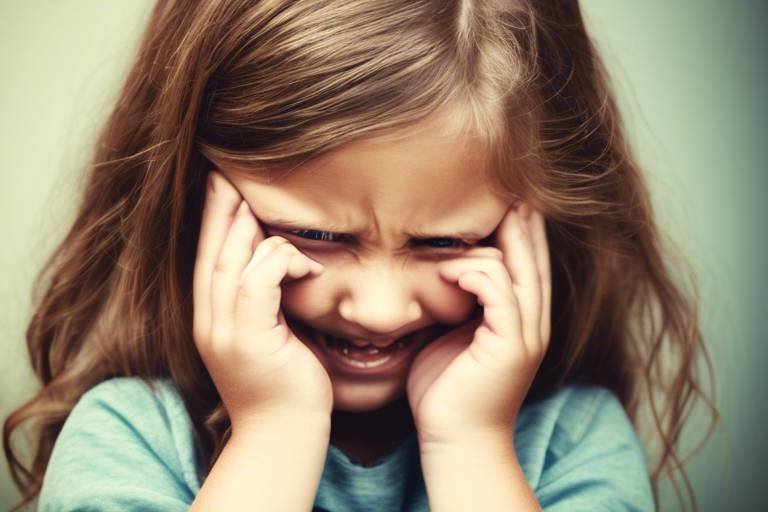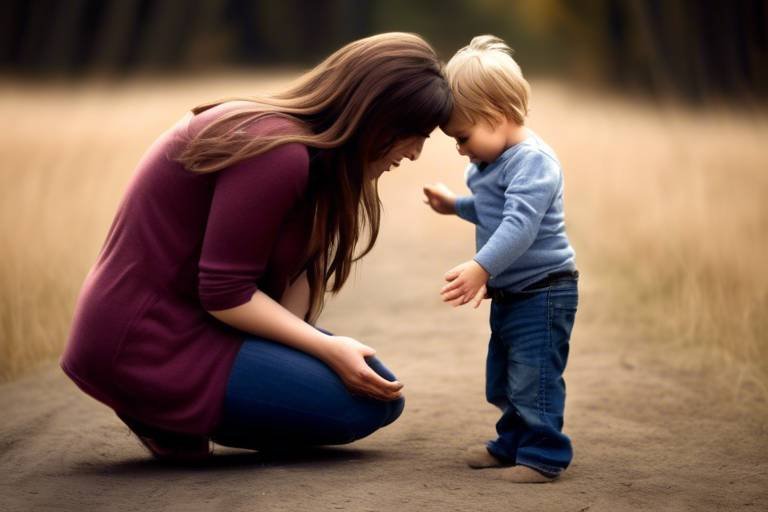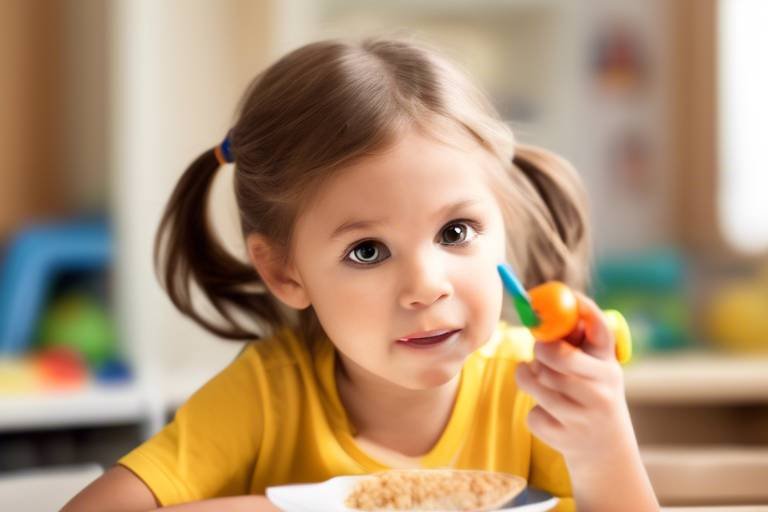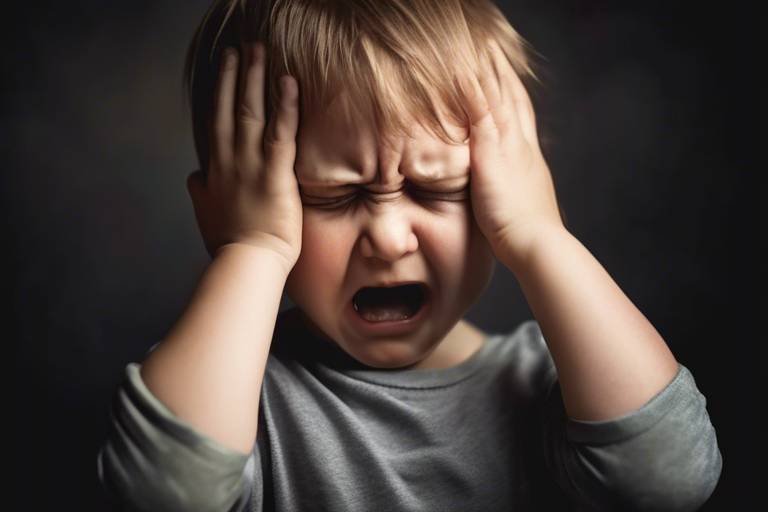Tips to Curb Aggression in Kids
As parents and caregivers, dealing with aggressive behavior in children can feel like navigating a minefield. One moment everything is calm, and the next, an explosion of frustration or anger can turn a peaceful day into chaos. It’s crucial to understand that aggression in kids isn't just a phase; it’s often a signal that they need help managing their emotions. By employing effective strategies, we can guide them towards healthier emotional expressions and interactions. So, how do we tackle this challenging behavior? Let’s dive into some insightful tips that can make a significant difference.
Recognizing the different forms of aggression can help parents address the underlying issues. Aggressive behavior in children can manifest in numerous ways, such as physical aggression (hitting, kicking), verbal aggression (yelling, name-calling), and relational aggression (excluding others, spreading rumors). Understanding these types can help pinpoint the root causes, which might stem from frustration, fear, or even a desire for attention. It’s essential to remember that aggression often signals deeper emotional struggles, and addressing these can lead to healthier behavior.
Understanding what triggers aggressive behavior in kids is crucial. Common triggers include feelings of frustration, jealousy, or environmental factors like noise and chaos. For instance, a child might lash out when they’re overwhelmed by a noisy environment or when they feel they’re not receiving enough attention from parents. Recognizing these triggers can help parents intervene before the aggression escalates. Here are some common triggers:
- Frustration due to unmet expectations
- Jealousy over siblings or peers
- Environmental stressors like loud noises or crowded spaces
A child’s environment can significantly influence their behavior. This includes family dynamics, school settings, and peer relationships. For example, a supportive family can help mitigate aggressive tendencies, while a chaotic home environment may exacerbate them. It’s important to create a nurturing atmosphere where children feel safe to express their feelings without fear of judgment.
Family interactions and relationships play a pivotal role in shaping a child's behavior. Positive family dynamics, characterized by open communication and emotional support, can significantly reduce aggression. Conversely, negative dynamics, such as conflict or lack of attention, can lead to increased aggressive behaviors. It’s vital for families to foster a loving environment where children feel valued and understood.
School environments and peer interactions also impact children's behavior. Children may imitate aggressive behaviors they observe in their peers or feel pressured to conform to aggressive social norms. This section emphasizes the importance of teaching children to navigate social situations constructively. Schools that promote kindness and inclusion can help mitigate aggressive tendencies, creating a more positive environment for all students.
Teaching children how to manage their emotions is essential in reducing aggression. Emotional regulation techniques can be incredibly effective in helping kids learn how to cope with their feelings. Simple practices such as deep breathing, counting to ten, or using “I feel” statements can empower children to express themselves without resorting to aggression. For example, instead of hitting when upset, a child can learn to say, “I feel angry because I wanted to play with that toy.” This shift in expression can lead to healthier interactions.
Open communication can help children express their feelings without resorting to aggression. Creating an environment where kids feel comfortable sharing their thoughts and emotions is crucial. By using effective communication strategies, parents can encourage children to articulate their feelings in a constructive manner. For instance, instead of dismissing a child's anger, parents can validate their feelings and help them find words to express what they’re experiencing.
Practicing active listening can strengthen parent-child relationships. When parents take the time to listen attentively, children feel understood and valued, which can significantly reduce aggressive outbursts. Active listening involves not just hearing the words but also paying attention to the emotions behind them. This connection helps children feel supported and encourages them to express themselves more openly.
Encouraging children to articulate their feelings can lead to better emotional management. Parents can help by modeling emotional expression and providing a safe space for kids to share. Techniques like using feeling charts or storytelling can facilitate discussions about emotions. When children learn to express their feelings constructively, they are less likely to resort to aggression.
Q: What are some signs that my child may be struggling with aggression?
A: Signs may include frequent temper tantrums, physical fights with peers, or difficulty managing frustration. If these behaviors are persistent, it may be beneficial to consult a professional.
Q: How can I help my child if they are being bullied?
A: Encourage open dialogue about their feelings, and work with them to develop coping strategies. It's also essential to communicate with teachers or school staff to address the situation effectively.
Q: Are there specific activities that can help reduce aggressive behavior?
A: Yes! Activities like sports, arts and crafts, or even mindfulness exercises can provide healthy outlets for emotions and help children learn to channel their energy positively.

Understanding Aggression in Children
When it comes to understanding aggression in children, it’s essential to recognize that this behavior can manifest in various forms. Aggression isn’t just about hitting or yelling; it can also include verbal outbursts, non-verbal cues, and even passive-aggressive actions. By identifying these different types, parents can better address the underlying issues that may be fueling such behavior.
There are generally three main types of aggression observed in children:
- Physical Aggression: This includes hitting, kicking, or any form of physical harm directed at others.
- Verbal Aggression: This form involves yelling, name-calling, or using hurtful language to express frustration or anger.
- Relational Aggression: This type focuses on damaging someone’s relationships or social status, often through gossip or exclusion.
Understanding the causes behind these aggressive behaviors is equally important. Children may act out due to a variety of factors, such as:
- Frustration: When children feel overwhelmed or unable to express their needs, aggression can be a misguided outlet.
- Jealousy: Feelings of envy, especially among siblings or peers, can trigger aggressive responses.
- Environmental Factors: A chaotic home environment or exposure to violence can lead to heightened aggression.
Moreover, it's crucial to consider the developmental stage of the child. For instance, toddlers may lash out simply because they lack the verbal skills to articulate their feelings. As they grow, their understanding of social norms evolves, but this doesn’t mean that aggression will automatically diminish. In fact, if not addressed, aggressive behaviors can become ingrained and manifest in more complex ways during adolescence.
In summary, recognizing the various forms of aggression and understanding their potential causes can equip parents and caregivers with the tools they need to effectively manage and reduce these behaviors. By fostering a supportive environment and promoting healthy emotional expression, we can help children navigate their feelings in a constructive manner.

Identifying Triggers
Understanding what triggers aggressive behavior in kids is crucial for parents and caregivers. Think of it like a volcano; if you can identify the signs of pressure building up, you can prevent an explosive eruption. Aggression in children often doesn’t come out of nowhere. Instead, it can be linked to specific situations or feelings. By recognizing these triggers, you can take proactive steps to address the underlying issues before they escalate.
Common triggers for aggressive behavior in children include:
- Frustration: When kids face challenges they cannot overcome, their feelings of frustration can boil over into aggression. This might happen during homework or when they can't play with a toy the way they want.
- Jealousy: Children often struggle with feelings of jealousy, especially when they perceive that another child is getting more attention or praise. This can lead to aggressive behaviors as they express their discontent.
- Environmental Factors: The environment plays a significant role in shaping a child’s behavior. Loud noises, chaotic surroundings, or even too much screen time can provoke aggressive outbursts.
These triggers can vary widely from one child to another, making it essential for parents to observe their child’s behavior closely. For instance, a child may react aggressively when they feel overwhelmed by noise or when they are tired. Identifying these patterns can be the key to preventing future incidents.
Moreover, it’s important to consider the role of peer relationships. Children often mimic behaviors they see in their friends or siblings. If they are surrounded by peers who express frustration through aggression, they may learn to do the same. This is why fostering healthy peer interactions is vital in curbing aggressive tendencies.
By keeping track of these triggers, parents can develop a better understanding of their child’s emotional landscape. A simple chart or table can help in tracking these triggers over time:
| Trigger | Possible Response |
|---|---|
| Frustration | Provide assistance or break tasks into smaller steps. |
| Jealousy | Encourage sharing and highlight each child's unique strengths. |
| Environmental Factors | Create a calming space or limit overstimulating activities. |
In summary, identifying triggers is a vital step in managing aggression in children. By being aware of the situations that lead to aggressive behavior and understanding the underlying emotions, parents can take meaningful actions to help their children express themselves in healthier ways. Remember, the goal isn't just to stop the aggressive behavior but to help children understand their emotions and learn to navigate them effectively.
Q: How can I help my child identify their triggers?
A: Encourage your child to talk about their feelings and experiences. Keeping a feelings journal can also help them recognize patterns in their emotions and behaviors.
Q: What should I do when my child exhibits aggressive behavior?
A: Stay calm and address the behavior without anger. Discuss what happened afterward and guide them in finding better ways to express their feelings.
Q: Are there professional resources available for managing aggressive behavior?
A: Yes, many therapists and counselors specialize in child behavior. They can provide tailored strategies and support for both the child and the parents.

The Role of Environment
The environment in which a child grows up is like the soil in which a seed is planted; it significantly influences how that seed will grow. A nurturing, supportive environment can help a child flourish, while a toxic or chaotic one can lead to aggressive behavior. It’s crucial for parents and caregivers to recognize that children are not just products of their genetics but are also shaped by their surroundings. This includes family dynamics, school settings, and peer relationships, all of which play pivotal roles in a child's emotional and behavioral development.
Family dynamics are often the first layer of a child's environment. If a family is marked by conflict, neglect, or lack of communication, children may respond with aggression as a way to express their frustration or to seek attention. Conversely, a family that promotes open dialogue, respect, and emotional support can foster an atmosphere where children feel safe to express themselves without resorting to violence. It's essential to create a home where feelings are validated, and healthy coping mechanisms are encouraged.
Next, let’s consider the school environment. Schools are not just places of learning; they are social arenas where children interact with their peers. A positive school climate can significantly reduce instances of aggression. When children feel accepted and valued by their peers and teachers, they are less likely to act out. However, in schools where bullying or social exclusion is prevalent, children may resort to aggressive behaviors as a defense mechanism or as a means of gaining control in a situation where they feel powerless.
Peer relationships can also serve as a double-edged sword. Friends can either encourage positive behavior or reinforce negative tendencies. For instance, children who associate with peers that exhibit aggressive behavior may feel pressured to conform to that dynamic. On the other hand, friendships that promote kindness and empathy can help mitigate aggressive tendencies. It’s essential for parents to encourage their children to build relationships with peers who exhibit positive behaviors.
In summary, the environment plays a crucial role in shaping a child's behavior. By recognizing and addressing the influences within family dynamics, school settings, and peer relationships, parents can help cultivate a nurturing atmosphere that promotes emotional health and reduces aggression. Consider this: if we want to cultivate kindness and understanding in our children, we must first ensure that their surroundings reflect those values.

Family Dynamics
Family dynamics play a crucial role in shaping a child's behavior, especially when it comes to aggression. Think of your family as a garden; if the soil is rich and well-tended, the plants will flourish. Conversely, if the environment is toxic or neglected, even the hardiest plants can wither. In the same way, a child's emotional and behavioral growth can be significantly impacted by the interactions and relationships within their home. Positive family dynamics are essential for fostering a sense of security and emotional well-being, while negative dynamics can lead to confusion, frustration, and ultimately, aggressive behavior.
One of the key factors to consider is how parents communicate with each other and their children. If children witness constant conflict or poor communication between parents, they might internalize these behaviors as acceptable ways to express their feelings. For instance, when parents argue frequently, children might learn to mimic this aggression, believing that yelling or fighting is a normal part of resolving conflicts. On the other hand, families that engage in open, respectful dialogues can teach children healthier ways to express their emotions.
Moreover, the emotional climate of the household is equally important. A warm, supportive environment encourages children to express their feelings openly, while a cold or critical atmosphere may lead them to bottle up their emotions until they explode. It’s essential for parents to create a nurturing space where children feel safe to share their thoughts and feelings without fear of judgment. This involves not only verbal communication but also non-verbal cues, such as body language and facial expressions, which can significantly influence how children perceive emotional interactions.
Additionally, parental involvement in a child's life can either mitigate or exacerbate aggressive tendencies. Engaging in activities together, such as playing games, reading, or simply talking, can strengthen bonds and provide children with a sense of security. When children feel connected to their parents, they are less likely to resort to aggression as a means of expressing discomfort or frustration. However, when parents are absent or disengaged, children may feel neglected, leading to feelings of anger and resentment that can manifest as aggressive behavior.
In summary, the dynamics within a family can either nurture a child's emotional development or contribute to aggressive behavior. It's vital for parents to be aware of their interactions and the overall emotional atmosphere of their home. By fostering positive communication, emotional support, and active involvement, families can create a healthy environment that encourages children to express their feelings constructively rather than through aggression.
- What are the signs of aggression in children? Aggressive behavior can manifest as physical actions, such as hitting or kicking, as well as verbal outbursts like yelling or name-calling. Children may also exhibit signs of frustration or withdrawal when faced with challenging situations.
- How can I encourage positive communication in my family? Set aside time for family discussions, practice active listening, and encourage everyone to share their thoughts and feelings without interruption. This helps create a safe space for open dialogue.
- What role does discipline play in managing aggression? Consistent and fair discipline is crucial. It’s important to set clear expectations and consequences for aggressive behavior, while also teaching children alternative ways to express their feelings.

School and Social Influences
The school environment and social interactions play a crucial role in shaping a child's behavior, including aggressive tendencies. Imagine a garden where the plants thrive or wither based on the sunlight and water they receive; similarly, children flourish or falter depending on their social surroundings. When kids are surrounded by supportive peers and positive role models, they are more likely to develop healthy emotional responses. However, when they encounter negativity, bullying, or peer pressure, aggression can rear its ugly head.
One of the most significant factors is the peer group. Children often look to their friends for cues on how to behave. If a child is surrounded by peers who exhibit aggressive behavior, they may feel pressured to conform. This can lead to a cycle where aggression begets aggression, creating an environment where such behavior is normalized. Additionally, the competitive nature of school can exacerbate feelings of frustration and inadequacy, prompting aggressive outbursts as a misguided attempt to assert dominance or gain attention.
Furthermore, the school culture itself can either promote or hinder aggressive behavior. For instance, schools that foster a sense of community and belonging typically see lower levels of aggression. On the other hand, institutions plagued by bullying or a lack of engagement can create a hostile atmosphere, making children feel isolated and angry. It’s essential for educators and parents to work together to cultivate a positive school climate where children feel safe and supported.
To better understand how school and social influences contribute to aggression, consider the following factors:
- Peer Pressure: Children may mimic aggressive behaviors to fit in with their friends.
- Bullying: Victims of bullying may retaliate or become aggressive themselves.
- Teacher Interactions: Supportive teachers can help mitigate aggression, while negative interactions can escalate it.
- Extracurricular Activities: Participation in sports or clubs can provide positive outlets for energy and emotions.
In conclusion, navigating the complexities of school and social influences requires vigilance and proactive measures from both parents and educators. By fostering a supportive environment, encouraging positive peer relationships, and promoting open communication, we can help children manage their emotions effectively and reduce aggressive behaviors. Remember, just like a well-tended garden, children need the right conditions to grow into healthy, well-adjusted individuals.
Q: How can I tell if my child's aggression is a serious issue?
A: If your child's aggressive behavior is frequent, intense, or leads to harm to themselves or others, it's essential to consult a professional.
Q: What role do parents play in managing aggression?
A: Parents are pivotal in modeling appropriate behavior, providing emotional support, and teaching conflict resolution skills.
Q: Can aggression in children be reduced through therapy?
A: Yes, therapy can help children learn to manage their emotions and develop healthier coping strategies.
Q: Are there specific activities that can help reduce aggression?
A: Engaging in sports, arts, and mindfulness practices can provide positive outlets for energy and emotions, reducing aggressive tendencies.

Emotional Regulation Techniques
Managing emotions can sometimes feel like trying to tame a wild beast, especially for children who are still learning to navigate their feelings. Teaching kids is essential for reducing aggression and promoting healthier interactions. One effective approach is to introduce simple breathing exercises. For instance, when a child feels overwhelmed, they can take a moment to breathe in deeply through their nose, hold it for a few seconds, and then exhale slowly through their mouth. This technique not only calms the body but also provides a moment of pause, allowing them to think before reacting.
Another valuable technique is the use of visual aids. Creating a "feelings chart" can help children identify and articulate their emotions more effectively. This chart can include various emotions with corresponding facial expressions, helping kids recognize what they are feeling. For example, if a child sees a face showing anger, they might realize, "Hey, that’s how I feel right now!" This recognition is the first step towards managing their emotions.
Additionally, teaching children to use positive self-talk can empower them to handle their feelings constructively. Encourage them to come up with affirmations they can say to themselves during tough moments, such as "I can stay calm" or "It’s okay to feel upset." This internal dialogue can shift their mindset and help them regain control over their emotions.
It’s also important to create a safe space where children can express their emotions freely. This could be a designated area in the home filled with comforting items like soft pillows, stuffed animals, or art supplies. When kids know they have a place to retreat to when they feel overwhelmed, they are more likely to manage their feelings without resorting to aggression.
Finally, regular practice of these techniques is crucial. Just like learning to ride a bike, mastering emotional regulation takes time and patience. Encourage children to practice these skills regularly, perhaps by setting aside a few minutes each day to discuss feelings or practice breathing exercises together. Over time, these techniques will become second nature, allowing children to express their emotions in healthier ways.
- What are emotional regulation techniques? Emotional regulation techniques are strategies that help individuals manage their emotions effectively, allowing them to respond to situations in a calm and controlled manner.
- How can I teach my child emotional regulation techniques? You can teach your child emotional regulation techniques through breathing exercises, visual aids like feelings charts, positive self-talk, and creating a safe space for emotional expression.
- Why is emotional regulation important for children? Emotional regulation is important for children because it helps them cope with their feelings, reduces aggressive behavior, and fosters healthier relationships with peers and family members.
- At what age can children start learning emotional regulation techniques? Children can start learning emotional regulation techniques as early as preschool age, though the complexity of the techniques can be adjusted based on their developmental stage.

Effective Communication Strategies
When it comes to managing aggression in children, effective communication is like a secret weapon in your parenting toolkit. Think about it: when kids feel heard and understood, they’re less likely to lash out. It’s all about creating a safe space where they can express their feelings without fear of judgment. This doesn’t mean you have to be a child psychologist, but a little bit of intentional communication can go a long way. So, how do we foster this kind of environment? Let’s dive into some strategies that can transform the way you connect with your child.
First off, active listening is key. This means not just hearing the words that come out of their mouths, but really tuning in to what they’re saying. Imagine your child is a tiny volcano, bubbling with emotions that need to erupt. If you ignore the signs, that volcano might explode! By practicing active listening, you can help diffuse that pressure before it builds up. This involves making eye contact, nodding, and even repeating back what they say to show you’re engaged. For instance, if your child says, “I’m mad because my friend didn’t let me play,” you could respond with, “It sounds like you’re feeling really upset about that.” This simple technique shows them that their feelings are valid.
Next, let’s talk about encouraging the expression of feelings. Kids often struggle to articulate what they’re going through, which can lead to frustration and, ultimately, aggressive behavior. By giving them the tools to express themselves, you’re not just helping them communicate; you’re also teaching them emotional literacy. You might say, “Can you tell me more about what made you feel that way?” or “What color do you think your feelings are right now?” This not only opens up the dialogue but also makes it a fun and engaging process. You could even create a feelings chart together, where they can point to colors or images that represent their emotions.
Another effective strategy is to model healthy communication yourself. Kids learn a lot by watching their parents. If they see you handling your frustrations calmly or discussing your feelings openly, they’re more likely to mimic that behavior. For example, if you’re feeling stressed about work, try saying, “I’m feeling a bit overwhelmed today, but I’m going to take a deep breath and figure it out.” This not only teaches them how to articulate feelings but also shows them that it’s okay to struggle sometimes.
Finally, setting aside dedicated time for conversations can make a world of difference. Just like you schedule playdates or family dinners, make it a point to have one-on-one time with your child. This doesn’t have to be a formal sit-down; it can be during a walk, while cooking together, or even at bedtime. The key is to ensure they know they have your undivided attention. During these moments, encourage them to share their thoughts about their day, their friendships, or anything that’s on their mind. This creates a routine that not only fosters communication but also strengthens your bond.
In summary, effective communication strategies are essential in curbing aggression in children. By actively listening, encouraging emotional expression, modeling healthy communication, and setting aside time for meaningful conversations, you can create a nurturing environment that supports your child’s emotional development. Remember, it’s not just about talking; it’s about connecting. And when you connect, you pave the way for healthier emotional expressions and interactions.
- What if my child refuses to talk about their feelings?
It's common for kids to be hesitant at first. Try to create a comfortable environment and let them know it's okay to share at their own pace. - How can I improve my active listening skills?
Practice by giving your full attention, avoiding interruptions, and summarizing what your child says to show understanding. - Are there specific techniques for younger children?
Use visual aids like emotion cards or drawings to help them express what they're feeling.

Active Listening
Active listening is more than just hearing the words that come out of your child's mouth; it's about truly understanding their feelings and emotions. When children express their thoughts, they often do so with a whirlwind of emotions swirling around them. By practicing active listening, you create a safe space for them to share, which can dramatically reduce instances of aggression. Think of it as holding up a mirror to their feelings, reflecting back what they say and how they feel, allowing them to see that their emotions are valid and important.
So, how can you become an active listener? It involves several key components that can transform your conversations with your kids:
- Give Full Attention: Put down your phone, turn off the TV, and make eye contact. Show your child that they are your priority in that moment.
- Reflect Back: Use phrases like, "It sounds like you're feeling..." or "I hear that you're upset because..." This not only shows that you're listening but also helps them clarify their own feelings.
- Avoid Interrupting: Let them finish their thoughts without jumping in. This teaches them that their voice matters.
- Ask Open-Ended Questions: Encourage deeper conversation by asking questions that require more than a yes or no answer, such as "What made you feel that way?"
By incorporating these techniques into your daily interactions, you can foster a deeper connection with your child. They will feel more understood, which can significantly decrease their frustration and, consequently, their aggressive behaviors. Remember, active listening is like planting seeds in a garden; the more you nurture these conversations, the more they will flourish into healthy emotional expressions.
In conclusion, active listening is a powerful tool for parents. It not only helps children articulate their feelings but also strengthens the bond between parent and child. When children feel heard, they are less likely to resort to aggression as a means of expressing their emotions. So, take a moment to listen actively – it may just be the key to unlocking a more peaceful home environment.
Q: How can I improve my active listening skills?
A: Start by minimizing distractions, maintaining eye contact, and practicing empathy. Reflecting on what your child says can also enhance your understanding.
Q: What if my child doesn't want to talk?
A: It's important to respect their space. Let them know you're available when they're ready to share, and try to create a comfortable environment for future conversations.
Q: How can I encourage my child to express their feelings?
A: Model emotional expression yourself. Share your feelings openly and encourage them to do the same. You can also use books or stories that discuss emotions to facilitate conversations.

Encouraging Expression of Feelings
Encouraging children to express their feelings is akin to giving them a toolbox filled with essential tools for emotional management. When kids learn to articulate their emotions, they not only understand themselves better but also build stronger connections with those around them. Think about it—if you had a friend who never shared their thoughts or feelings, how would that affect your relationship? The same principle applies to children. By fostering an environment where expressing emotions is not just accepted but encouraged, parents can significantly reduce instances of aggression.
One effective way to promote emotional expression is through **open-ended questions**. Instead of asking, "Did you have a good day?" try something like, "What was the best part of your day?" This invites children to share more than just a simple yes or no, and it encourages them to dive deeper into their feelings. When kids feel that their emotions are valid and worth discussing, they are more likely to share their thoughts openly. Another technique is to model emotional expression yourself. When you share your feelings, whether it’s joy, frustration, or sadness, you demonstrate that it’s okay to talk about emotions. Kids learn by example, and seeing you express your feelings can inspire them to do the same.
Moreover, creating a **safe space** for discussions about feelings is crucial. This can be a designated time each day where the family sits together and talks about their highs and lows. You might say, "Let’s share one thing that made us happy today and one thing that frustrated us." This not only normalizes the conversation around feelings but also teaches children how to articulate their emotions in a constructive way. It’s important to listen actively during these discussions, showing empathy and understanding, which reinforces the idea that their feelings matter.
Additionally, using **creative outlets** can be particularly effective for younger children. Activities such as drawing, painting, or even role-playing can help children express what they might struggle to say with words. For instance, you could encourage your child to draw a picture that represents how they feel about a certain situation. This can serve as a bridge to a more in-depth conversation about their emotions. By tapping into their creativity, children can often express complex feelings that they might otherwise keep bottled up.
In conclusion, encouraging children to express their feelings is not just about reducing aggression; it’s about nurturing emotional intelligence. When children feel equipped to express their feelings, they are less likely to resort to aggressive behavior as a means of communication. They learn that it’s okay to feel a spectrum of emotions and that expressing those feelings can lead to understanding and resolution. So, let’s empower our kids with the tools they need to navigate their emotional landscapes, ensuring they grow into empathetic and emotionally intelligent adults.
- Why is it important for children to express their feelings? Expressing feelings helps children understand their emotions, enhances communication skills, and reduces the likelihood of aggressive behavior.
- What are some signs that a child is struggling to express their feelings? Signs may include frequent outbursts, withdrawal from social interactions, or physical symptoms like headaches and stomachaches.
- How can I create a safe space for my child to express their feelings? Set aside regular time for discussions, practice active listening, and encourage sharing without judgment.
- What role do creative activities play in emotional expression? Creative activities allow children to express complex feelings in a non-verbal way, making it easier to discuss emotions they may find hard to articulate.
Frequently Asked Questions
- What are the common signs of aggression in children?
Common signs of aggression in children include physical outbursts like hitting or kicking, verbal outbursts such as yelling or name-calling, and destructive behaviors like breaking toys. Additionally, children may exhibit aggressive behavior when they feel overwhelmed or unable to express their emotions properly.
- How can I identify triggers for my child's aggressive behavior?
Identifying triggers involves observing your child's behavior in various situations. Common triggers include frustration, jealousy, or feeling ignored. Keeping a journal of incidents can help pinpoint patterns and specific situations that lead to aggressive outbursts.
- What role does the family environment play in a child's aggression?
The family environment is crucial in shaping a child's behavior. Positive family interactions can foster emotional security, while negative dynamics, such as conflict or lack of communication, may contribute to aggressive tendencies. It's essential to create a supportive atmosphere for your child.
- How can I teach my child to manage their emotions?
Teaching emotional regulation can be achieved through various techniques, such as role-playing scenarios, using feelings charts, or practicing deep breathing exercises. Encourage your child to express their feelings verbally and validate their emotions to help them learn to manage them better.
- What are some effective communication strategies for parents?
Effective communication strategies include practicing active listening, where you give your full attention to your child, and encouraging open dialogue about feelings. Using "I" statements can also help express your feelings without placing blame, fostering a healthier conversation.
- How can I encourage my child to express their feelings constructively?
Encouraging constructive expression of feelings can be done by creating a safe space for your child to share their thoughts. Use art, storytelling, or journaling as tools for expression. Reinforce that it's okay to feel emotions, and help them find appropriate ways to communicate those feelings.
- What should I do if my child's aggression escalates?
If your child's aggression escalates, it's important to remain calm and address the behavior immediately. Set clear boundaries and consequences, and consider seeking professional help if the aggression is persistent or severe. Consulting with a child psychologist can provide additional strategies tailored to your child's needs.



















